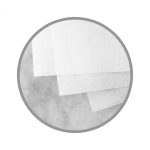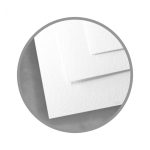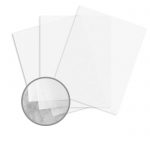Onion skin paper is a translucent paper known for its strength and gossamer thinness. It’s perfect for a variety of applications such as calligraphy, origami, crafting, and traditional animation, but it can be difficult to print on without special considerations.
This article covers everything you need to know about onion skin paper, including its uses, characteristics, and printing tips.
Onion skin paper—aptly named for its delicate, translucent appearance—is also known as onionskin and airmail or bible paper. This intriguing paper is full of delightful contradictions: it’s a joy to write on and superb at holding ink, but it poses challenges when it comes to printing. It’s excellent at holding crisp folds, but it’s so gossamer thin that it goes limp under its own weight.
Highly valued by creative communities, onion skin paper is beloved by many for its unique properties. But it is also shrouded in mystery, and it can be challenging to find and even more difficult to find information about how best to use it.
Not to worry—we’ve got the #onionskinny on onion skin paper.
In this article, we will cover:
- What is onion skin paper?
- Is onion skin paper the same as tracing paper?
- How thick is onion skin paper?
- What is onion skin paper used for?
- Printing on onion skin paper
- Key characteristics and specifications
Now, let’s peel back those layers and dive in.
What is Onion Skin Paper?
Onion skin paper is a thin, translucent writing paper. It can be white or yellow and is available in ultra-light basis weights like 10 lb bond. Made with a high percentage of long cotton fibers and/or hydrated chemically treated wood pulp, onion skin paper is surprisingly strong for such a lightweight paper.
After forming, it is sized with rosin, starch, or glue and then plated or supercalendered to produce a smooth, durable finish.
PRO TIP: In the paper production process, “sizing” refers to the application of a material, often an adhesive, to a paper to improve absorption and wear. It has nothing to do with the literal size of a sheet of paper.
Onion skin paper can also be air dried to create a cockle finish, which is slightly wavy and inconsistent in appearance and feel due to the air drying process.

Smooth Finish Onion Skin Paper

Cockle Finish
onion skin paper and is intended to
act as reference only)
This waviness and inconsistency by design produce that irresistible crackling sound when onion skin paper is handled. The crackling may sound scary, but it’s actually a desirable feature because it prevents the thin sheets from sticking together. Although most onion skin papers currently being manufactured do not come with a cockle finish, this feature is quite beloved in online communities.
Is Onion Skin Paper the Same as Tracing Paper?
No, onion skin paper is not the same as tracing paper. While it can be used as tracing paper, it is not technically the same thing. Tracing paper is even thinner and more translucent than onion skin.
How Thick is Onion Skin Paper?
Onion skin paper is less than a millimeter thick. It’s commonly available in either a 9 or 10 pound basis weight, but basis weights can range from 7 to 10 pounds depending on the manufacturer.
What is Onion Skin Paper Used for?
Onion skin paper has many applications, including:
- Creating duplicate copies of typewritten material
- Permanent records where low bulk is important
- Printing thick books that can become overly bulky, such as the bible and complete dictionaries
- Traditional cel animation
- Airmail correspondence
- Calligraphy
- Crafting, cardmaking, and scrapbooking
- Toy kites and paper airplanes
- Origami
- Confetti
- Creating frosted windows in model trains and craft projects
- Making lampshades and lanterns
Printing on Onion Skin Paper
Printing on onion skin paper can be challenging, whether you’re printing at home or in a commercial print shop.
While it may not be technically approved for any printing processes, onion skin paper isn’t impossible to print on (though your mileage may vary, depending on the type of printer you are using). Follow these tips for the best possible results when printing on onion skin paper.
Offset printing on onion skin paper
Onion skin paper is suitable for offset inks and standard binding processes, with special handling and pretesting recommendations to achieve optimal results. Unlike regular office printers, offset presses allow you to make adjustments for feeding and printing on thinner sheets.
That means you can often print onion skin like any conventional uncoated paper, but due to the very low basis weight, we strongly recommend pretesting to make sure your particular offset printing press will handle the paper.
Laser and inkjet printing on onion skin paper
Always pretest your laser and inkjet printing equipment, as this very light paper may not work with some devices. Onion skin paper is not guaranteed to work in inkjet or laser printers (like most of us have at home).
Challenges with printing on onion skin paper
Onion skin paper is so thin that not every printer can grab the sheet to run it through. Depending on the type of ink used and how stiff (or thick) the paper is, the ink can sometimes smear.
Expert tips for best printing results
- Keep onion skin paper products wrapped until the moment of printing. It is essential to let the paper acclimate for a minimum of 24 hours (or longer during cold weather) in the press room while still wrapped in mill packaging.
- Onion skin products must be kept covered during drying, between passes, and prior to any finishing work. Pull each sheet off the printer to keep them from touching, then let them dry separately.
- Pressroom conditions should be as close as possible to 68 degrees, and 45-60% relative humidity.
- Use a slip sheet to help with feeding. To do this at home, attach each sheet of onion skin paper to a piece of normal printer paper with removable double-sided tape or a loop of painter’s tape. If your printer offers the option to hand-feed sheets, you can also use that method to avoid any problems with the rollers not being able to grab the onion skin.
- Varnish is optional as a surface protector.
Key Characteristics & Specifications
The Unique Charm & Versatility of Onion Skin Paper
Onion skin paper is a unique paper with qualities that make it beloved by many creative communities. Despite its challenges in printing and handling, its strength, translucency, and distinctive texture make it a favorite for various creative and practical applications, from reducing bulk and airmail correspondence to calligraphy, origami, and even traditional animation.
Whether you’re preserving typewritten documents, creating delicate crafts, or simply enjoying the tactile pleasure of its crisp folds and crackling sound, onion skin paper offers a delightful experience for those who appreciate its delicate yet durable nature. So, armed with the right knowledge and tips, dive into the world of onion skin paper and explore the endless possibilities it offers.



